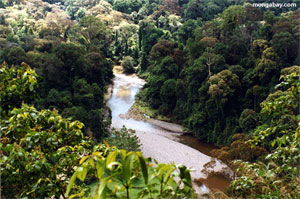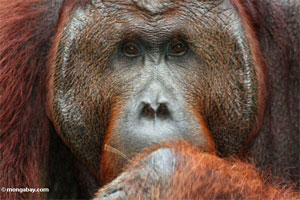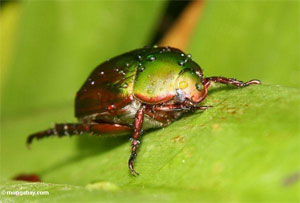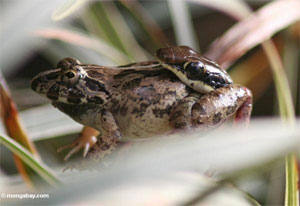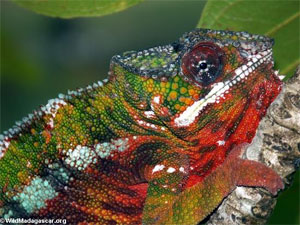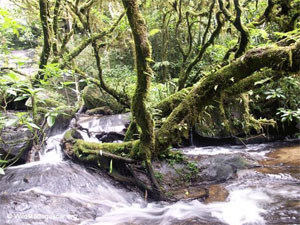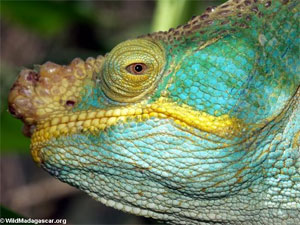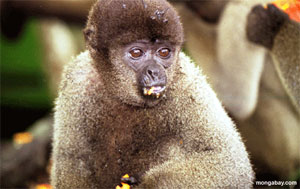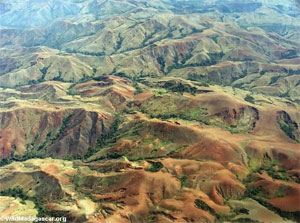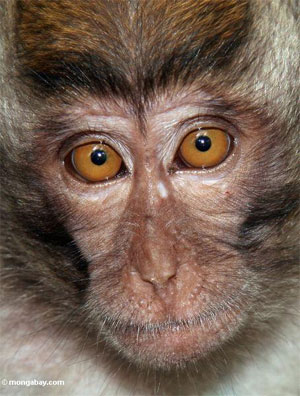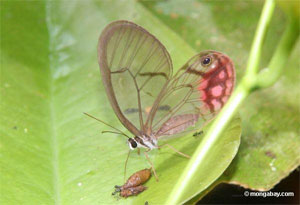Rainforest education site goes online; resources for students, teachers, and journalists
mongabay.com
April 12, 2006
With Earth Day fast approaching it’s time to take another look at the world’s most biodiverse ecosystems
Mongabay.com, a leading environmental-science web site, announced today a revised version of a rainforest site, that has been a major resource on such forests for teachers, students, and researchers. The expanded and updated site is now available at http://rainforests.mongabay.com.
“Mongabay.com is dedicated to providing necessary communication to those interested in the fate of our rainforests,” Ira Rubinoff, director of the Smithsonian Tropical Research Institute (STRI), said. “It has a scientific base that should provide reliable information to all who share an interest in the future quality of life on this planet.”
The revised site includes environmental profiles and deforestation statistics for more than 60 countries, and features thousands of rainforest wildlife photos from around the world Additionally, the site includes a section geared towards children, with learning activities and educational resources for teachers.
“Mongabay.com aims to be an excellent educational resource for children and adults alike,” Rhett A Butler, founder of the site, said. “I believe a key part to rainforest conservation is education—both in local communities around forest areas and in industrialized countries where consumption decisions can drive deforestation. However, I also think that it is important to extend beyond rainforests, stimulating a greater appreciation of natural and wildlife in general. It’s hard to miss something if you don’t know it’s there in the first place.”
Tropical rainforests are a world like no other, Butler added, and their importance to the global ecosystem and human existence is unquestioned. Unparalleled in their biological diversity, they are a natural reservoir of genetic diversity offering a rich source of medicinal plants, high-yield foods, and a myriad of other useful forest products. They are an important habitat for migratory animals and sustain as much as 50 percent of the species on Earth, as well as a number of diverse and unique indigenous cultures. Tropical rainforests play an fundamental role in regulating global weather in addition to maintaining regular rainfall, while buffering against floods, droughts, and erosion. They store vast quantities of carbon, while producing a significant amount of the world’s oxygen.
Butler noted that tropical rainforests, like so many other natural places, are increasingly scarce as we advance into the 21st century. The vast swaths of forest, swamp, desert, and savanna that carpeted Earth’s land surface a mere five generations ago have been reduced to scattered fragments; today, more than two-thirds of the world’s tropical rainforests exist as fragmented remnants. Less than 5 percent of Earth’s land is covered with these forests (about 2.41 million square miles or 625 million hectares) but this area is being diminished at a rate exceeding 80,000 acres (32,300 ha).
Contrary to what one might expect, deforestation rates have not slowed in recent years. Analysis of figures from the Food and Agriculture Organization of the United Nations (FAO) shows that tropical deforestation rates increased 8.5 percent from 2000-2005 when compared with the 1990s, while loss of primary forests may have expanded by 25 percent over the same period. Nigeria and Vietnam’s rate of primary forest loss has doubled since the 1990s, while Peru’s rate has tripled.
Overall, the FAO estimates that 10.4 million hectares of tropical forest were permanently destroyed each year in the period from 2000 to 2005, an increase since the 1990-2000 period, when around 10.16 million hectares of forest were lost. Among primary forests, annual deforestation rose to 6.26 million hectares from 5.41 million hectares in the same period. On a broader scale, FAO data shows that primary forests are being replaced by less biodiverse plantations and secondary forests. Because of a significant increase in plantation forests, forest cover has generally been expanding in North America, Europe, and China while diminishing in the tropics. Industrial logging, conversion for agriculture (both for commercial production and the subsistence needs of rural populations), and forest fires—often purposely set by people—are responsible for the bulk of global deforestation today.
As rainforests around the world still continue to fall, it raised the question of whether it really make a difference? Why should anyone care if some plants, animals, mushrooms, and microorganisms fade away? Besides rainforests in distant, unpronounceable lands are often hot and humid, difficult to reach, insect-ridden, and have elusive wildlife.
Scientists will argue that the concern extends beyond losing a few plants and animals. By destroying the tropical forests, we risk our own quality of life, gamble with the stability of climate and local weather, threaten the existence of other species, and undermine the valuable services provided by biological diversity.
“What other single ecosystem harbors millions of species and countless indigenous human cultures, locks up billions of tons of carbon and thus slows global warming, protects delicate soils from erosion, and helps to stabilize our global climate?” asks William F. Laurance, a world authority in tropical conservation biology, who currently works with the Smithsonian Tropical Research Institute in Panama and the Biological Dynamics of Forest Fragments Project in Brazil. “Rainforests do more than protect biodiversity; they play a truly vital role in keeping our planet liveable,” he says.
While in most areas, environmental degradation has yet to reach a crisis level where entire systems are collapsing, scientists like Laurance believe it is important to examine some of the effects of existing environmental impoverishment and to forecast some of the potential repercussions of forest loss. Continuing loss of natural systems could make human activities increasingly vulnerable to ecological surprises in the future.
The most immediate impact of deforestation occurs at the local level with the loss of ecological services provided by tropical rainforests and related ecosystems. Such habitats afford humans valuable services such as erosion prevention, flood control, water treatment, fisheries protection, and pollination—functions that are particularly important to the world’s poorest people, who rely on natural resources for their everyday survival. Forest loss also reduces the availability of renewable resources like timber, medicinal plants, nuts and fruit, and game.
Over the longer term, deforestation of tropical rainforests can have a broader impact, affecting global climate and biodiversity. These changes are more difficult to observe and forecast from local effects, since they take place over a longer time scale and can be difficult to measure.
“Rainforests and coral reefs, two of our planet’s most diverse living ecosystems, exhibit and poorly understood interactions and interdependencies,” Rubinoff of the STRI says. “Temporal fluctuations in the abundance of their component organisms have not been adequately quantified. Moreover, society treats these habitats as a commons with all of the historical management difficulties this entails. In spite of these challenges or perhaps because of them and the inherent diversity and beauty of the systems–an army of scientists, economists, politicians, conservationists, apply themselves to the task of their protection.”
While preserving rainforests for the future is not going to be an easy task, it is possible. Saving rainforests will require developing a new conservation policy built on the principle of sustainable use and development of rainforests—economic, political, and social pressures will not allow rainforests to persist if they are completely closed off from use and development. Beyond the responsible development of rainforests, efforts to rehabilitate and restore degraded forest lands along with the establishment of protected areas are key to securing rainforests for the long-term benefits they can provide mankind.
Saving the forests, oceans, wetlands, deserts, and tundra of the world may require a fundamental change in the way we humans see the world around us. Butler notes that it is our underlying philosophy, one that has been conditioned since birth, that has turned so many of Earth’s unique ecosystems into places in peril today.
As much as we may want to believe it, man is not apart from nature,” Butler added. “People are not exempt from the laws of nature nor the sole heir of all the precious resources of this planet. Our place in the universe is not to conquer Earth and cultivate the entire planet to suit our needs, while extinguishing those species that do not directly benefit us. What is imperative to our species and all other species is biological diversity. This biodiversity crisis that we are facing today transcends religions, though traditional religions, both tribal and institutional, lend support to the preservation of biodiversity.”
He observed that what makes life on Earth livable for our species is biodiversity—from tigers in Bhutan to sea cucumbers living on the coral reefs of Madagascar to the mites on your cheese. “By extinguishing hotbeds of biodiversity—rainforests, wetlands, coral reefs, and grasslands—we are destroying a part of ourselves. Biodiversity will recover after humanity is gone, but in the meantime, the continuing loss of our fellow species will make Earth an awfully crowded, but lonely, place.”
Butler concludes, “The extinction event that is presently occurring rivals the extinctions caused by natural disasters of global ice ages, planetary collisions, atmospheric poisoning, and variations in solar radiation. The difference is that this extinction was conceived by humans and subject to human decisions. We are the last, best hope for life as we prefer it on this planet.”
